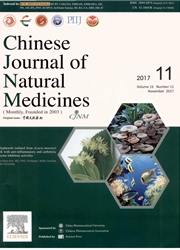

 中文摘要:
中文摘要:
Sex hormone estrogen is one of the most active intrinsic angiogenesis regulators; its therapeutic use has been limited due to its carcinogenic potential. Plant-derived phytoestrogens are attractive alternatives, but reports on their angiogenic activities often lack in-depth analysis and sometimes are controversial. Herein, we report a data-mining study with the existing literature, using IPA system to classify and characterize phytoestrogens based on their angiogenic properties and pharmacological consequences. We found that pro-angiogenic phytoestrogens functioned predominantly as cardiovascular protectors whereas anti-angiogenic phytoestrogens played a role in cancer prevention and therapy. This bidirectional regulation were shown to be target-selective and, for the most part, estrogen-receptor-dependent. The transactivation properties of ERα and ERβ by phytoestrogens were examined in the context of angiogenesis-related gene transcription. ERα and ERβ were shown to signal in opposite ways when complexed with the phytoestrogen for bidirectional regulation of angiogenesis. With ERα, phytoestrogen activated or inhibited transcription of some angiogenesis-related genes, resulting in the promotion of angiogenesis, whereas, with ERβ, phytoestrogen regulated transcription of angiogenesis-related genes, resulting in inhibition of angiogenesis. Therefore, the selectivity of phytoestrogen to ERα and ERβ may be critical in the balance of pro- or anti-angiogenesis process.
 英文摘要:
英文摘要:
Sex hormone estrogen is one of the most active intrinsic angiogenesis regulators; its therapeutic use has been limited due to its carcinogenic potential. Plant-derived phytoestrogens are attractive alternatives, but reports on their angiogenic activities often lack in-depth analysis and sometimes are controversial. Herein, we report a data-mining study with the existing literature, using IPA system to classify and characterize phytoestrogens based on their angiogenic properties and pharmacological consequences. We found that pro-angiogenic phytoestrogens functioned predominantly as cardiovascular protectors whereas anti-angiogenic phytoestrogens played a role in cancer prevention and therapy. This bidirectional regulation were shown to be target-selective and, for the most part, estrogen-receptor-dependent. The transactivation properties of ERa and ERβ by phytoestrogens were examined in the context of angiogenesis-related gene transcription. ERa and ERβ were shown to signal in opposite ways when complexed with the phytoestrogen for bidirectional regulation of angiogenesis. With ERa, phytoestrogen activated or inhibited transcription of some angiogenesis-related genes, resulting in the promotion of angiogenesis, whereas, with ERβ, phytoestrogen regulated transcription of angiogenesis-related genes, resulting in inhibition of angiogenesis. Therefore, the selectivity of phytoestrogen to ERa and ERβ may be critical in the balance of pro- or anti-angiogenesis process.
 同期刊论文项目
同期刊论文项目
 同项目期刊论文
同项目期刊论文
 Preparative Isolation and Purification of Four Compounds from Cistanches deserticola Y.C. Ma by High
Preparative Isolation and Purification of Four Compounds from Cistanches deserticola Y.C. Ma by High Astragalosides Rescue Both Cardiac Function and Sarcoplasmic Reticulum Ca2+Transport in Rats with Ch
Astragalosides Rescue Both Cardiac Function and Sarcoplasmic Reticulum Ca2+Transport in Rats with Ch A rapid ultra performance liquid chromatography–tandem mass spectrometric method for the qualitative
A rapid ultra performance liquid chromatography–tandem mass spectrometric method for the qualitative Antagonism of Cortex Periplocae extract-induced catecholamines secretion by Panax notoginseng saponi
Antagonism of Cortex Periplocae extract-induced catecholamines secretion by Panax notoginseng saponi Ginsenoside Rg3 antagonizes adriamycin-induced cardiotoxicity by improving endothelial dysfunction f
Ginsenoside Rg3 antagonizes adriamycin-induced cardiotoxicity by improving endothelial dysfunction f Cardioprotection against ischemia/reperfusion injury by QiShenYiQi Pill (R) via ameliorate of multip
Cardioprotection against ischemia/reperfusion injury by QiShenYiQi Pill (R) via ameliorate of multip Vascular relaxation induced by Eucommiae Ulmoides Oliv. and its compounds Oroxylin A and wogonin: im
Vascular relaxation induced by Eucommiae Ulmoides Oliv. and its compounds Oroxylin A and wogonin: im Effects of Fructus Psoraleae Extract on the Intestinal Absorption Kinetics of Geniposide and Genipos
Effects of Fructus Psoraleae Extract on the Intestinal Absorption Kinetics of Geniposide and Genipos Pharmacokinetics study of asperosaponin VI and its metabolites cauloside A, HN saponin F and hederag
Pharmacokinetics study of asperosaponin VI and its metabolites cauloside A, HN saponin F and hederag A UPLC-MS/MS method for in vivo and in vitro pharmacokinetic studies of psoralenoside, isopsoralenos
A UPLC-MS/MS method for in vivo and in vitro pharmacokinetic studies of psoralenoside, isopsoralenos A UPLC–MS/MS method for in vivo and in vitro pharmacokinetic studies of psoralenoside, isopsoralenos
A UPLC–MS/MS method for in vivo and in vitro pharmacokinetic studies of psoralenoside, isopsoralenos Cuscuta chinensis Lam.: A systematic review on ethnopharmacology, phytochemistry and pharmacology of
Cuscuta chinensis Lam.: A systematic review on ethnopharmacology, phytochemistry and pharmacology of Estrogenic properties of six compounds derived from Eucommia ulmoides Oliv. and their differing biol
Estrogenic properties of six compounds derived from Eucommia ulmoides Oliv. and their differing biol LC/MS/MS determination and pharmacokinetic studies of six compounds in rat plasma following oral adm
LC/MS/MS determination and pharmacokinetic studies of six compounds in rat plasma following oral adm Separation and Purification of Two Isomeric Saponins from Albiziae Cortex by High-Speed Counter-Curr
Separation and Purification of Two Isomeric Saponins from Albiziae Cortex by High-Speed Counter-Curr Ultra high performance liquid chromatography with photodiode array detector and quadrupole time-of-f
Ultra high performance liquid chromatography with photodiode array detector and quadrupole time-of-f A randomized, double-blind, placebo-controlled trial of Chinese herbal medicine granules for the tre
A randomized, double-blind, placebo-controlled trial of Chinese herbal medicine granules for the tre Bioactivity-integrated UPLC/Q-TOF–MS of Danhong injection to identify NF-κB inhibitors and anti-infl
Bioactivity-integrated UPLC/Q-TOF–MS of Danhong injection to identify NF-κB inhibitors and anti-infl Anti-inflammatory Activity of Baicalein in LPS-Stimulated RAW264.7 Macrophages via Estrogen Receptor
Anti-inflammatory Activity of Baicalein in LPS-Stimulated RAW264.7 Macrophages via Estrogen Receptor 期刊信息
期刊信息
